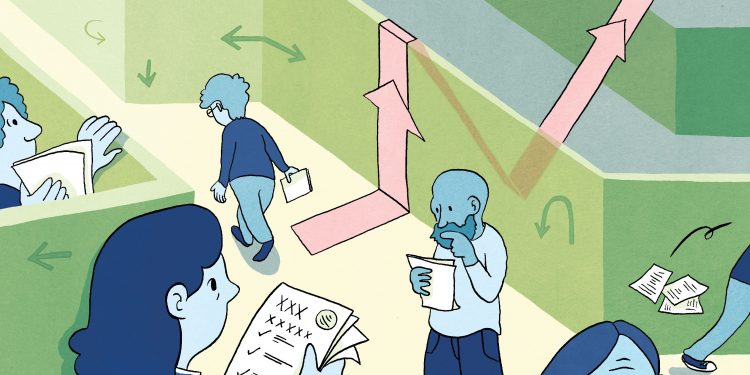Enrollment in the program rose by more than 388,000 people, or 13.7%, including in counties that, historically, have been wealthier than some of their counterparts.
Ed Mahon of Spotlight PA and Ese Olumhense of Spotlight PA
Spotlight PA is an independent, non-partisan newsroom powered by The Philadelphia Inquirer in partnership with PennLive/The Patriot-News, TribLIVE/Pittsburgh Tribune-Review, and WITF Public Media. Sign up for our free newsletters.
HARRISBURG — There are many ways to measure the pain being felt by people in Cumberland County.
More families in the region are becoming homeless, social services groups said, sleeping in tents and cars. Many others need help getting food.
Over the past year, the Central Pennsylvania Food Bank has seen a roughly 40% increase in the amount of people coming to them for help, said Joe Arthur, its executive director.
“We think that this is probably going to take two years or better to work our way back to the level we were pre-pandemic, in terms of folks needing our help,” Arthur said.
And as unemployment dramatically spiked, reaching a high of 12% in April last year, thousands of people in the central Pennsylvania county turned to the government for health care.
Cumberland County saw a nearly 22% increase in Medicaid enrollment from February 2020 to the same month this year. While that represents the greatest increase in the state, it’s far from an outlier.
Enrollment in the program rose by more than 388,000, or 13.7%, during the same time period — reaching 3.2 million people in February. The change represents a dramatic expansion of Pennsylvania’s social safety net, exceeding single-year Medicaid enrollment increases that occurred during the Great Recession, a Spotlight PA analysis found.
That’s in part because more people can apply for Medicaid than in the past. In 2015, Democratic Gov. Tom Wolf expanded eligibility beyond specific groups — including people with disabilities, the elderly, pregnant women, and children — to adults that meet certain income requirements. Single adults between the ages of 19 and 64 are eligible if they earn about $17,775 a year or less.
The enrollment increase also reflects the widespread economic devastation that the coronavirus caused across the state.
Many of the counties that saw the largest increases in enrollment during the pandemic are ones that are historically wealthier and have lower poverty rates. The median household income in Cumberland County is about $71,000 a year, nearly $10,000 more than across the state.
Others were already struggling. Dauphin County, which ranked high for the number of residents overall who rely on Medicaid, saw the third-largest increase in enrollment in the health-care program over the past year. Now, 30% of the county’s 278,000 residents participate.
“The virus exacerbated the flaws that were already in our system,” said Danielle Krebs, a spokesperson for the Harrisburg-based Tri County Community Action, which provides financial services and programs for low-income residents of Dauphin, Cumberland, and Perry Counties. “Before the pandemic, people were already struggling on low income.”
Greater need, greater costs
The growth in Medicaid from January 2020 to the first month of this year exceeds similar growth in 15 of the prior 16 years. The only similar period that saw a bigger jump was after Wolf first took office and expanded Medicaid eligibility.
State officials have encouraged people to seek help through Medicaid and other programs during the pandemic, but that comes with a cost.
The Department of Human Services said it needs the GOP-controlled legislature to approve $941 million in extra funding to fill a hole in the budget lawmakers approved last year. Top Republicans have seized on the supplemental request to criticize the department’s growing budget and claim mismanagement.
“The taxpayers are not an open wallet that can continue to fund these kinds of increases,” said House Appropriations Chair Stan Saylor (R., York).
Human Services Secretary Teresa Miller said chronic underfunding is partially to blame as are long-term challenges. In addition to coverage through Medicare, the federal health insurance program designed for everyone 65 and older, low-income seniors can also use Medicaid to help cover long-term care and support services. And as Pennsylvania’s population grows older, those costs are rising.
“Our parents and grandparents need our services,” Miller told lawmakers this month. “And I’m fairly certain that we all want to ensure that DHS is here to serve them so they have the care and quality of life that they deserve.”
Medicaid represents a massive and far-reaching amount of money. Pennsylvania spent nearly $33 billion on the program in the federal fiscal year that ended in September 2019, according to a report from the nonpartisan Medicaid and CHIP Payment and Access Commission. The federal government covered about 58% of those costs with the state picking up the rest.
At the moment, total Medicaid enrollment in Pennsylvania is artificially inflated because of federal pandemic rules.
Under a policy that began under former President Donald Trump, the department can’t remove people from the program if their income rises above the usual limits. Instead, officials can only disenroll people if they move out of state, die, or voluntarily withdraw.
“We’re currently carrying at least 257,000 people on Medicaid who would not otherwise be eligible,” Miller told lawmakers during a budget hearing earlier this month.
About $476 million of the department’s $941 million supplemental funding request is related to that policy, according to a Wolf administration estimate.
Still, Miller said the additional cost is less of a concern because the federal government is sending billions more to the state through enhanced Medicaid payments.
In the long term, many state Republicans support adding work requirements for so-called “able-bodied” adults in the Medicaid program, a move they say would help people earn their way out of poverty and could reduce costs for the state.
The department has in the past noted that people who are older or who have disabilities account for the largest share of Medicaid spending, not working-age adults. And currently, according to the department, about 46% of people receiving coverage through Medicaid expansion work full- or part-time jobs — only slightly lower than how many were working before the pandemic.
During a recent budget hearing, state Sen. David Argall (R., Schuylkill) brought up the governor’s prior vetoes of work requirements and urged the administration to set specific targets for how many enrollees it moves into the workforce.
“I realize in the last year everything’s been turned upside down with this terrible pandemic,” Argall said afterward. “But someday this pandemic will end, and I still believe it’s an issue that we need to address.”

‘It’s a very scary thing’
Rachel Weisberg started hunting for health insurance in early 2020. Some of the political organizer’s friends had already started getting laid off from their jobs, and Weisberg, then 26, was about to lose coverage.
The Philadelphia resident had two realistic options — get enrolled or go without insurance, just as the coronavirus was beginning to spread around the country.
But enrolling was more complicated than Weisberg anticipated, even with help from a friend at the Pennsylvania Health Access Network, a consumer group that helps people obtain health care.
There were forms to fill out, documents to gather, and bank and tax statements to provide. There was some math involved, too: Her income from working on local Democratic campaigns was often seasonal, but she was required to convert her pay into an annual figure. Details had to be carefully verified. And, from time to time, the enrollment website acted up, and Weisberg would get error messages. Finally, when the paperwork was done, came an excruciating wait to find out whether she was approved or not.
“It’s a very scary thing,” Weisberg said. “The one month of my life that I guess that I haven’t had any form of health insurance was March 2020, which is kind of a hilarious thing because that was when everything was hitting the fan. I was like, ‘If I get COVID this month, I swear to God.’”
The coronavirus forced many people to navigate the state’s public assistance system for the first time, advocates told Spotlight PA.
Members of the advocacy group Put People First! PA organized outdoor events where volunteers helped people fill out the applications for Medicaid and other public benefits.
“The demand is increasing, but people still need a lot of help to access Medicaid,” said Nijmie Dzurinko, co-coordinator and co-founder of the group.
Department officials said they partner with community organizations that help enroll people and pointed to a 2019 report from Code for America that found Pennsylvania’s online application is more user-friendly than many other states in several measures, including the estimated time it takes to complete an application.
But advocates countered that the process of identifying benefits one is eligible for and signing up can still be difficult and time-consuming.
John Williams, a 43-year-old from Delaware County’s Ridley Township, had a job working with autistic adults. He got furloughed in the spring, returned to work in June, but by the end of November, the program where he worked closed and he was laid off again.
Williams spent weeks trying to get money through the state’s unemployment system. Bills piled up. He had to deal with funeral expenses and other issues from his mom’s death in December. Williams looked for things he could try to sell on eBay — radio control cars, comic books, some of his mom’s old ceramic birds, and anything he could find in storage.
He turned to the Department of Human Services’ programs for help. While it was better than the unemployment compensation system, he still thought the process was harder to navigate than it needed to be.
“I went to college for pre-law, and I’m struggling with this form,” Williams said. “It’s like they’re almost trying to trap you to see if you’re fraudulent, which I get. I get it. But it’s so difficult.”
In February, Williams received an approval letter for food stamps and a rejection for cash assistance. But he didn’t follow through with seeking Medicaid coverage. He said the system was frustrating. He worried about insurance confusion once he started working again. And he felt reluctant to receive more government assistance.
He did find a new job — it pays about $8 less an hour than his old one — and expects to start in a few weeks. For now, Williams is uninsured, hoping he doesn’t get sick, and relying on help from siblings and some of the unemployment money that has started to come in.
“I hate being a charity case,” Williams said. “I was not raised to be.”
WHILE YOU’RE HERE… If you learned something from this story, pay it forward and become a member of Spotlight PA so someone else can in the future at spotlightpa.org/donate. Spotlight PA is funded by foundationsand readers like you who are committed to accountability journalism that gets results.



